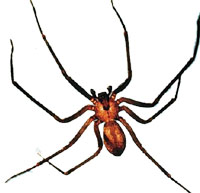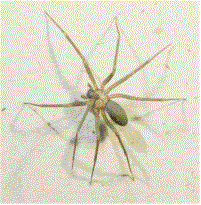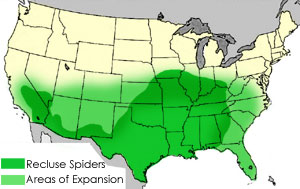Identify A Spider - Learn
about Hobo Spiders - FAQ - Q&A
at the Spider Forum - Order Traps

What does a Brown Recluse Spider look like?
 The
most recognized feature of the Brown Recluse spider is violin pattern
on the cephalothorax or, in other words, the location on the top side
of the spider near the head. Thus they have been nicknamed the Fiddleback
Spider. This characteristic is common in adult brown recluses, but some
young brown recluse spiders do not have any contrasting pigmentation in
the violin region.
The
most recognized feature of the Brown Recluse spider is violin pattern
on the cephalothorax or, in other words, the location on the top side
of the spider near the head. Thus they have been nicknamed the Fiddleback
Spider. This characteristic is common in adult brown recluses, but some
young brown recluse spiders do not have any contrasting pigmentation in
the violin region.
 Recluse
spiders also have abdomens devoid of any coloration pattern. Their legs
lack thickened spines but are covered with fine hairs.
Recluse
spiders also have abdomens devoid of any coloration pattern. Their legs
lack thickened spines but are covered with fine hairs.
Unlike most U.S. spiders, the Brown Recluse spider has six eyes arranged
in pairs called dyads. (Most U.S. spiders have eight eyes arranged in
two rows of four.) One dyad is anterior, or toward the front, and the
other two are lateral, or toward the sides of the cephalothorax (where
the first legs of the spider attach to the body). All 13 species of U.S.
recluses have this same eye pattern.
Where do Brown Recluse Spiders live?
 The
south central regions of the United States are the most common territories
of the Brown Recluse Spider.
The
south central regions of the United States are the most common territories
of the Brown Recluse Spider.
The boundaries start in Nebraska, go down through Texas, and then east through Georgia. From Georgia, they go north through Ohio and then, back to Nebraska. This area includes Nebraska, Iowa, Illinois, Indiana, Ohio, Kansas, Missouri, Kentucky, Oklahoma, Arkansas, Mississippi, Alabama, Georgia, Texas, Louisiana.
Areas that border this territory may still have Brown Recluse Spiders,
but they would be less commonly found. There are also instances that Brown
Recluse Spiders may be shipped with products from these states and consequently
find themselves in homes outside of the natural territory.
How can I control them?
If you live in Brown recluse territory, our SpiderExpert traps are recommended by spider experts for catching Brown Recluse Spiders instead of poisons and pesticides.
Rather than exposing yourself and your family to certain poisons (spray & pesticides), place Non-Poisonous and Natural Attractant Baited SpiderExpert Trapsto trap Brown Recluse Spiders when they move into your homes to keep you feeling safe.
Email Photos - Are they real?
Many people have been circulating a series of images showing a terrible bite with the skin deteriorating to the bone claiming the injury to be a brown recluse spider bite. An expert offers the following:
It is possible that the wound did result from a recluse bite. However, a number of aspects of this story are pretty suspicious, and have the classic symptoms of a hoax.
No one can seem to verify where the alleged bite occurred, whether a spider was caught in the act of biting or at the scene of the crime, whether the victim was tested for additional etiologic agents of necrosis such as bacterial infection, if a doctor actually made the diagnosis or it was a self-diagnosis from the victim, if the diagnosis came from an area of the country that actually has brown recluses, etc.
Some versions of this have included a picture of a spider that was supposed THE spider that caused the wound. Not so. It is a stock photo from an Ohio university website. This image was used last year in a very hyperbolic news story in Long Island.
The final summary on this is that if it indeed is a brown recluse bite, then it is truly one of the rare, horrific ones however, there is not sufficient information provided with this image to ascertain whether it is credible or not.
Rick Vetter Entomology Univ. Calif. Riverside Riverside, CA 92521
Learn about Hobo Spiders.
Read Frequently Asked Questions.
Have your questions answered in our Forum.